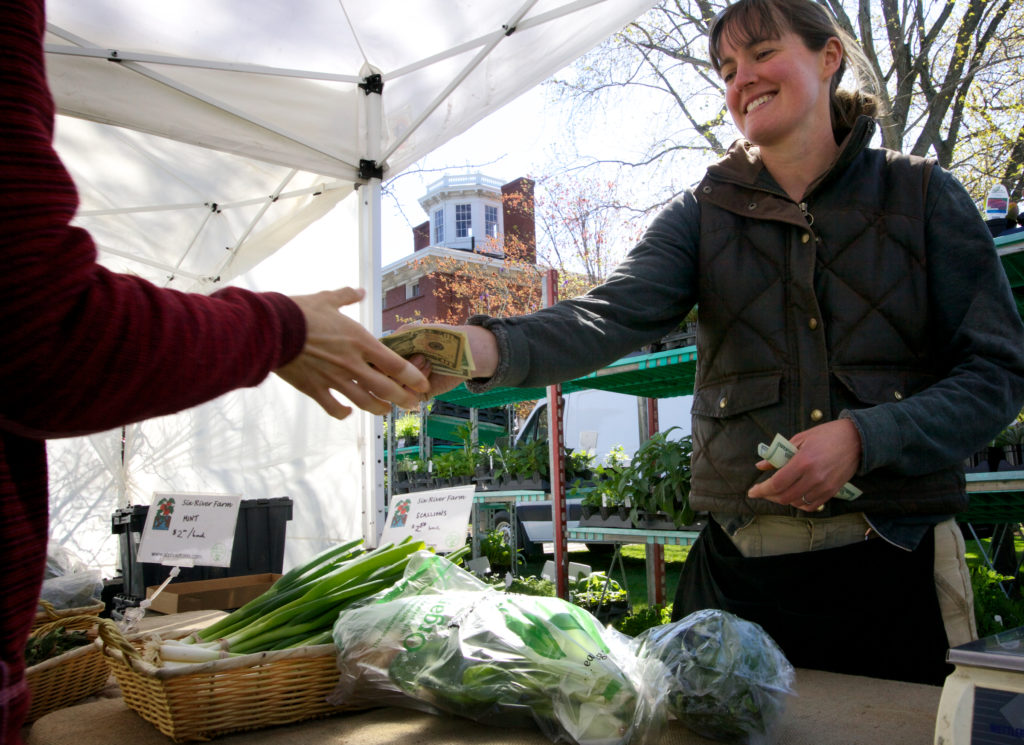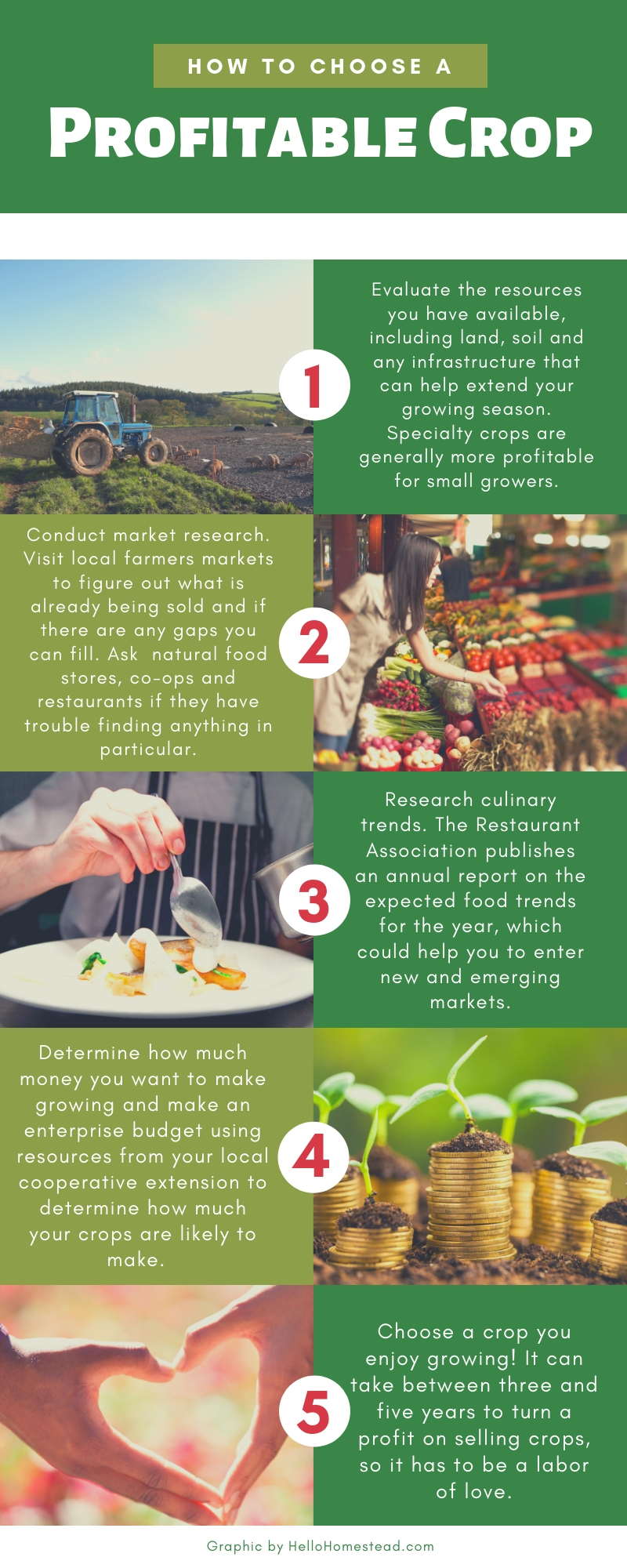What Types Of Crops Actually Make Money On Small Scale

Growing your own food is rewarding, but if you have been successfully gardening for several seasons, you lot may be wondering nigh selling produce or how to select the best crops to grow to brand money.
Some crops may draw more attention at the local farmers market — a juicy crimson tomato or a spectacularly speckled, uniquely-shaped summer squash — only experts say that for farmers looking to make a profit, there is no silver bullet in terms of choosing what to abound.
"Tomatoes or salad greens are the first two things that come to mind if people really pressed me, but information technology's certainly not a prescription to make a turn a profit," said Erica Frenay, online class manager at the Cornell Pocket-sized Farms Program at Cornell University. "It depends on your local market place, your skill ready, your soil, your microclimate and your macroclimate."
The all-time crops to grow to make coin will depend on what consumers in your expanse are willing to buy, as well as the fourth dimension, money and resources yous take to invest.
"Some people accept had proficient luck with tomatoes, simply in some areas y'all can inappreciably give away tomatoes in August or September," said Jason Lilley, sustainable agronomics professional person at the University of Maine Cooperative Extension.
In Maine, for case, Lilley said it would be much harder to make money selling a belatedly summer tomato in Portland than in areas of northern Maine where the market is less saturated with local growers.
Instead of asking what the best to grow to make money are, Frenay said that farmers looking to make a profit should reframe the question: in my situation, given everything, what is going to be the best ingather for me to sell?
Step 1: Effigy out what resources you have bachelor
First, figure out what resources you are working with on your farm or homestead. For starters, the amount of land y'all accept volition limit what you tin feasibly grow.
"One crop that's really popular is sweet corn, but the amount of infinite that it takes in add-on to the pest control, fertilizer and weeding makes it a very difficult crop to make money on," Lilley added. "Even though anybody wants sweet corn, you really need to be on a larger scale. That's one thing many farmers larn the difficult way."
Frenay besides recommended conducting a soil examination to develop an agreement of your soil's acidity, fertility level and limerick in order to determine what crops will go all-time on your land.
The infrastructure you accept available — season extenders, for example — tin also give you an advantage on the selling market.
"The but way to get a premium on tomatoes is to get them to the market place before anyone else, which requires more infrastructure," Frenay said.
"Some growers that have invested in high tunnels, which make it so you tin grow earlier or later in the season, and they have had really good luck with leafy greens and salad mixes," Lilley added. "That can exist fairly profitable."
Choosing your crops will as well depend on how much of another, less tangible resources you have available: time.
"You could produce year round or really desire to focus on a flavor," Dill said. "Say I teach or I'thousand a nurse, and I want to be really busy during strawberry flavor and become it over with. Sometimes the flavor works actually well for part-time farmers."
Step 2: Conduct market place research
The next step in finding a profitable ingather for you is do some research to find out what people in your area are interested in buying.
"It's about finding that consumer and whether they're willing to pay breakeven or more for that production," said Shannon Dill, extension educator and co-chair of the Beginning Farmer Success program at the Academy of Maryland Cooperative Extension.
Dill said that if there is a farmers marketplace where you are interested in selling, spend a few weekends walking around to see who your competitors are and what products are already available.
Consider partnering with a larger, more than experienced farm to fill any gaps they may have in your inventory, Dill said. For instance, if a farm at the marketplace primarily produces meat, you could grow garlic, onions and mushrooms to go along with the meat, perhaps for their Community Supported Agronomics (CSA) subscription boxes.
Yous can also visit other potential buyers, like restaurants, local co-ops and natural food stores, to see if there are any gaps they need filled.
"Go and enquire them if there is anything they accept a hard time finding and to take those conversations style before yous plant anything," Lilley said. "The wintertime is a great time to do that."

Step 3: Stay abreast of trends
If y'all are producing in small quantities for local markets, Dill recommended picking a unique crop then you lot can corner the marketplace.
"Specialty crops or niche crops, as a rule, tin command more value, peculiarly if you lot only have access to 1 or ii acres," Dill said.
Keeping abreast of food trends may also help you lot to fill emerging markets, especially if you are interested in selling your produce to restaurants. The Eating place Clan publishes an annual culinary trends forecast that predicts what will be hot that upcoming year.
Though it tin can be assisting, Dill said to employ caution when committing to trendy crops.
"You can get almost too niche for your consumer," Dill said. "The last thing you want is for people to non buy considering they don't know what to do with it. We saw some of that with baby vegetables and patty pan squash."
Dill said you tin can help promote your specialty products past giving your customers samples, providing them with fact sheets on the shelf-life and proper storage for the crops or handing out recipes, merely ultimately, you lot are gambling on your consumers' gustation.
Step 4: Make up one's mind your financial goals
Dill also said to consider your financial goals from growing.
"How much do you want to brand? Is it $v,000 or is it $50,000? Are you quitting your job or supplementing your job?," Dill said. "Work backwards from at that place."
Dill recommended creating an enterprise upkeep — an estimated income and expense related to the ingather — before you start growing. She said that these budgets often practice not take into account disease or pests or weather-related issues, but at least it will assistance yous toll your product.
"As people are looking at different types of crops a lot of extension services write up and have these budgets available," Dill said. "They're a great template. I know that the farm paperwork isn't generally the most popular with any farmers, simply being realistic with the numbers is actually important."

Step 5: Abound something y'all love
Regardless of what you grow, experts agree that yous should enjoy growing it. Selling crops is not always immediately or immensely profitable, and then it also has to exist a labor of love.
"Generally speaking, we say that almost people should not expect to make a huge turn a profit the first three — sometimes, five — years of growing," Lilley said. "There is a lot of time investment and investment of materials that goes into growing any sort of crop. Information technology can be a very rewarding business t, but you want to make certain that you're keeping it in line with things that y'all actually enjoy doing."

Source: https://hellohomestead.com/best-crops-to-grow-to-make-money/
Posted by: chaneysnate1999.blogspot.com

0 Response to "What Types Of Crops Actually Make Money On Small Scale"
Post a Comment